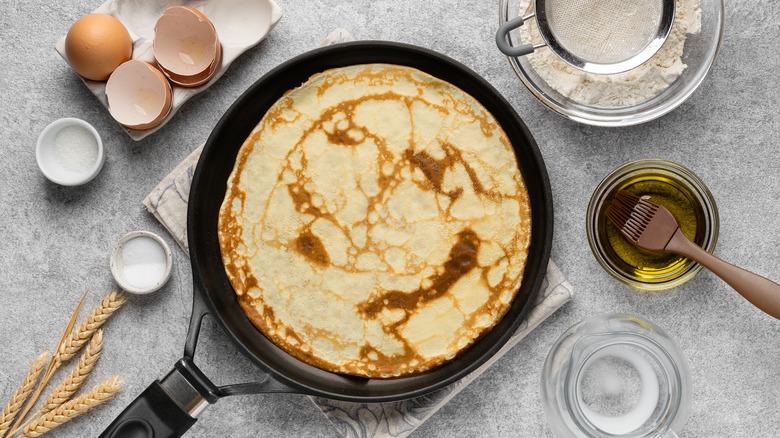The Unexpected Ingredient Julia Child Used In Crêpes
In so many ways, Julia Child was like the rest of us. Similar to how you might despise peas or liver, there were foods Child couldn't stand, too. There was also a dish that changed her life and set her career trajectory in the culinary world, and while all of us might not be able to relate to that, we can appreciate it.
But the beloved chef's success in developing recipes, cookbooks, and, eventually, the television programs that made her a household name (via The Julia Child Foundation) were based in part on how approachable she was, and how she could take something seemingly impossible like French cooking and make it accessible to the average American. Through the patient, simple instructions Child would include in her cookbooks, and the easy manner she displayed on shows like "The French Chef" and "Baking with Julia," it was easy to feel like you knew her.
Then again, Child always seemed to have a few surprises up her sleeve. The cookbook author began her professional life working for a government intelligence agency in Washington D.C., sorting out spies and dealing with top-secret documents. Lucky for us, when it came to secret ingredients in her cooking, Child was not so secretive. And her crêpes, a staple of French cuisine, were no exception, containing one unexpected ingredient to take them to the next level.
Add some nutty flavor to your crêpes
Crêpes are "one of the most versatile edibles in the cooking world," Child explains during an edition of "The Way to Cook," a "video-book" based on Child's cookbook of the same name. Like a YouTube channel before such a thing existed, episodes of "The Way to Cook" feature a charismatic Child walking the audience through recipes from her book, with references to the recipe card numbers so that viewers can follow along at home using their cookbook. When Child reaches the crêpe card, you can practically feel the viewers draw their collective breath; crêpes are an essential element of French cuisine, and to do them Julia's way is to learn from a master.
After establishing a traditional base of water, flour, melted butter, and salt, the chef pours something unexpected into the mix. Is that a bottle of syrup in her hand? Cognac, to French things up a bit? Nope. "Just because I like the taste," Child explains, "I'm going to put in two or three drops of dark sesame oil." Of course, if this shocks you, Child assures "You don't have to put it in at all." But as usual, she is on to something.
As The Spruce Eats points out, dark sesame oil has a nutty flavor, adding a kick to whatever dish it graces with its presence. And if you don't have any on hand, here are 10 substitutes for sesame oil you may have.

